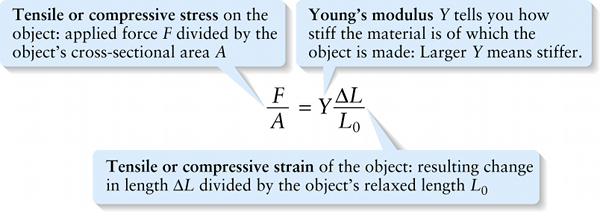Chapter 9. Hooke's law for an object under tension or compression (9-3)
Question
EM9MOdpX9hFYwOZ0RhyNTzKdUdujvDUsdI+ZzYNxl1Qu5x6ONkxZhK93PXdfMi01APizMFv0r3skIb0wNNUjV4o6+QAM8CDqZkUAvNBd45+frTR2pfNs/Qfqdkb8f+3pu8GIGBTUnys1N8TbtaZoMKegJbPfRm19xWam14ca7ixHdqayiRI2dw==
Question
WorWW3B3nT5iLM7Olq++PsX4Jd27UuL335mYpRtCoN0ftuqi52xCHqSfxzZQCmY+Gk47i4jOwVSVU4TNwVJCL8m/Wb58cqE+TmTMR+FK9d0GiVxLr73ghPFCQQk6VK/pY7Wo1LkGFRxpgcMpcZ6vPGS06gUapq3k16eCASrIJ34=
Question
UE5MXPSNikmjbvWlrNHqONF5vegHAWM9Dx6z381Kw/z/JA0zY7TeGyIAMw4bffZGo/fqbP6Rp2lbVQus16Qhy2gISmqbIRVpIycl1waHmrU0UFytWEXs9iVnsebCn1L9OHspZJuFJzhntiV6QgFhKw3j3Ufb/cxENKlOWr5iZyPYmgoQ
Review
Here’s a useful way to rewrite Hooke’s law for an object under tension or compression. This will also help us define \(\textit{stress}\) and \(\textit{strain}\) more precisely. First we substitute \(k\) from Equation 9-2 into Equation 9-1.
\(F = \left(Y\frac{A}{L_0}\right)\Delta{L}\)
Then we divide both sides by the cross-sectional area A:
